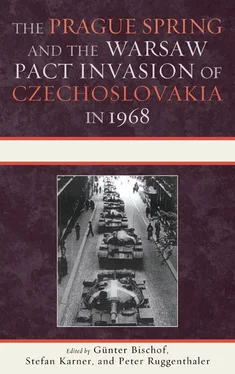FROM WARSAW TO MOSCOW: KÁDÁR’S LAST EFFORTS FOR A POLITICAL SETTLEMENT
After the Warsaw meeting, Kádár concentrated on persuading Brezhnev to make one more effort, to stage one more Soviet-Czechoslovak meeting in order to make it quite clear to Dubček and his comrades that in case they continued to do nothing to stop a development that bore all the hallmarks of total disintegration, there would have to be outside intervention to save the Socialist system. Kádár had the impression that he had succeeded in frightening Dubček and Černík in Komárom; at the end of the meeting, when they realized the danger they faced, both men burst out crying. 66He hoped that a last warning to the leadership by the Soviets would prove effective and trigger at long last the administrative measures required for a consolidation of the Communist system. The Soviet-Czechoslovak meeting in Čierna nad Tisou at the end of July was mainly the result of Kádár’s tireless efforts at mediation. At the ensuing meeting in Bratislava, Kádár confronted Dubček quite openly with the alternatives the KSČ had to choose between: either they themselves used force to stop certain tendencies or force would be applied from outside. He illustrated this with his own example and underlined that in 1956 it had been necessary to use deeply unpopular measures to save the Communist system in a context that was much more difficult; yet he had done what had to be done. 67
At Brezhnev’s invitation, Kádár went to Yalta on 15 August. During the ensuing negotiations, everyone knew that a decision in favor of a military solution was in the offing. Kádár now concentrated on the time after the intervention. The situation being as it was, he consented to the military solution, yet he emphasized that, in the long-term, only a political settlement can ensure success. The struggle for the correction of the mistakes made before January 1968 had to be continued, and the KSČ must not relinquish its two-front struggle. Kádár felt that the difficult situation the Soviets were in might provide him with an opportunity to criticize the policy of the CPSU in a constructive manner. He said the Soviet leadership had been impatient in its dealings with the Czechoslovak party and that this impatience had been a key factor in the escalation of the crisis; a more patient approach might have rendered military intervention unnecessary. In this context, he formulated a question that rose far above the present context: “When the CPSU is perceived as rigid by the world, by the global communist movement, who is going to play the role of the standard bearer in the global communist movement?” 68He praised Soviet policy after 1956 and said the Soviet leadership had then shown trust in the Hungarian and Polish party leaders and had allowed them to seek new solutions. This had brought a handsome dividend, for they were able to consolidate the situation in their countries. 69With these lessons from history Kádár was pursuing two goals. He was first of all trying to make sure that postinvasion Czechoslovakia would be allowed to reestablish order with minimum interference from the Soviets; second, he was trying to broaden with these arguments the maneuvering space in terms of domestic policies in the states of the Soviet Bloc.
In Yalta, Brezhnev entrusted a last mediation mission to Kádár, saying that the Hungarian party was the only one in addition to the CPSU to which Dubček might be prepared to listen. The meeting took place in Komárno on 17 August. It made one thing abundantly clear: the Czechoslovak leaders seemed completely unaware that they were sitting in a train that was heading for the abyss. Even if they suspected their predicament, they preferred resignedly to wait for the catastrophe; none of them had the courage to pull the emergency brake. It is little wonder that Kádár, who was notorious for his pragmatism, described the meeting as “embarrassing, ill tempered, sterile, pointless.” 70
After the invasion on 21 August, an unexpected opportunity arose for Kádár to influence the course of events positively. On the first day of the crisis management negotiations of the “Five,” which took place parallel to the Soviet’s talks with the captive Czechoslovak “delegation” between 24 and 26 August in Moscow, he was a fervent advocate of the need to find a compromise with the legitimate Czechoslovak leadership. In order to give emphasis to this Hungarian point of view, he first submitted it to the Soviets in writing.
Ulbricht and Zhivkov clearly advocated a dictatorial solution, the formation of a revolutionary government of workers and peasants in keeping with the Hungarian model of 1956. Gomułka, who was apparently completely out of his depth, went as far as to claim that the situation in Czechoslovakia was much worse than the one in Hungary at the time of the “counterrevolution.” 71In view of the fact that there were a number of influential supporters of a radical solution among the Soviet leaders themselves, Kádár, with his plea for Dubček and his comrades, came down clearly on the side of the realistic solution also favored by Brezhnev and Aleksei Kosygin. He thereby contributed in the end to a political compromise being hammered out that involved the legitimate Czechoslovak leaders and culminated in the signing of the Moscow Protocol.
Translated from German to English by Otmar Binder, Vienna.
1. For an overview of the history of the Prague Spring, see H. Gordon Skilling, Czechoslovakia’s Interrupted Revolution (Princeton, NJ: Princeton University Press, 1976); Karen Dawisha, The Kremlin and the Prague Spring (Berkeley: University of California Press, 1984); Jaromír Navrátil et al., eds., The Prague Spring 1968 (Budapest: Central European University Press, 1998); Kieran Williams, The Prague Spring and Its Aftermath: Czechoslovak Politics, 1968–1970 (Cambridge: Oxford University Press, 1997). On Hungary’s economic reform in 1968, see Ivan T. Berend, The Hungarian Economic Reforms, 1953–1988 (Cambridge: Oxford University Press, 1990).
2. Magyar Országos Levéltár [Hungarian National Archives] (hereafter cited as MOL) M-KS-288, F. 4/92, minutes of the meeting of the HSWP CC, 19–20 June 1968.
3. While in the Soviet Bloc, there had been two other serious crisis situations as well, the local leaders did not have to play a similar role in those cases. In June 1953 while crushing the Berlin uprising, the Soviet military commander directed operations, and Ulbricht and his comrades returned from hiding only after order was restored. In October 1956 during the Polish crisis, Gomułka did not have to save the Communist system, but avoid a Soviet military intervention which he did and consequently emerged from the crisis as a most popular leader.
4. For the role of the Hungarian army in the invasion of Czechoslovakia, see Iván Pataky, A vonakodó szövetséges: A Magyar Népköztársaság és a Magyar Néphadsereg közreműködése Csehszlovákia 1968. évi megszállásában [The Wavering Ally: The Participation of the Hungarian People’s Republic and the Hungarian People’s Army in the Occupation of Czechoslovakia in 1968 ] (Budapest: Zriínyi Kiadó, 1996).
5. MOL, M-KS-288, F. 5/467, minutes of the meeting of the HSWP CC, 20 August 1968.
6. For details on the Hungarian Revolution in 1956, see Csaba Békés, et al., eds., The 1956 Hungarian Revolution: A History in Documents (Budapest: Central European University Press, 2002).
7. For a comparative analysis of the two crises, see Csaba Békés, Európából Európába: Magyarország konfliktusok kereszttüzében 1945–1990 [ From Europe to Europe: Hungary in the Crossfire of Conflicts, 1945–1990 ] (Budapest: Gondolat, 2004), 223–36.
Читать дальше












